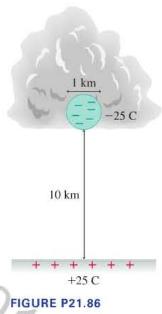If (12.5 mathrm{C}) of charge is transferred from the cloud to the ground in a lightning strike,
Question:
If \(12.5 \mathrm{C}\) of charge is transferred from the cloud to the ground in a lightning strike, what fraction of the stored energy is dissipated?
A. \(12 \%\)
B. \(25 \%\)
C. \(50 \%\)
D. \(75 \%\)
Storm clouds build up large negative charges, as described in the chapter. The charges dwell in charge centers, regions of concentrated charge. Suppose a cloud has \(-25 \mathrm{C}\) in a \(1.0-\mathrm{km}\)-diameter spherical charge center located \(10 \mathrm{~km}\) above the ground, as sketched in Figure P21.86. The negative charge center attracts a similar amount of positive charge that is spread on the ground below the cloud. The charge center and the ground function as a charged capacitor, with a potential difference of approximately \(4 \times 10^{8} \mathrm{~V}\). The large electric field between these two "electrodes" may ionize the air, leading to a conducting path between the cloud and the ground. Charges will flow along this conducting path, causing a discharge of the capacitor-a lightning strike.
Step by Step Answer:

College Physics A Strategic Approach
ISBN: 9780321907240
3rd Edition
Authors: Randall D. Knight, Brian Jones, Stuart Field





